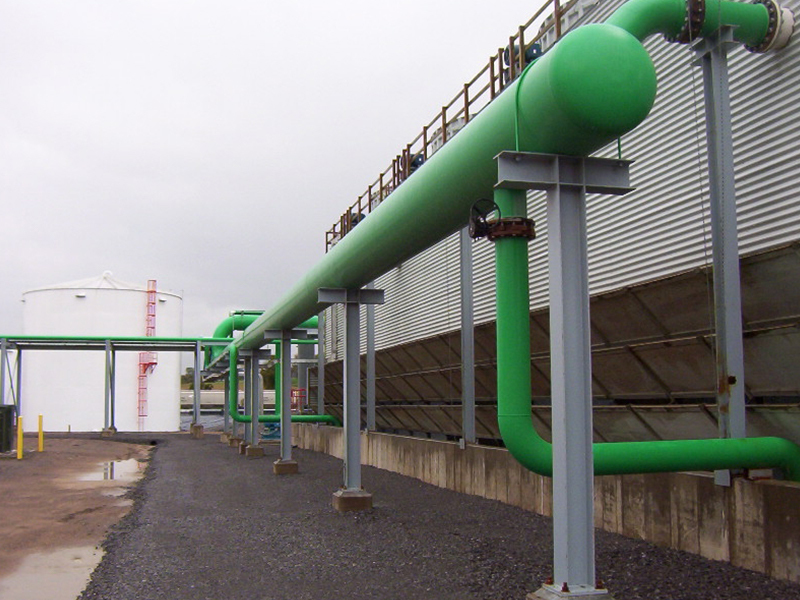When operating cooling towers, solids build up in the recirculated water. Cooling towers effectively scrub large volumes of air, which adds solids consisting of dust, microbiological organisms, and various airborne debris. Tower water can also have suspended solids from the make-up water source (e.g., turbidity), chemical treatment products, microbiological growth, and even wood fibers from the tower itself. As they settle, these solids can lead to many problems within the system, and even the best treatment program can be severely strained. A side stream filter can minimize solids build-up and prevent these potential issues.
Side stream filtration is a proven method that can benefit your cooling system through:
- Reduced corrosion rates
- Increased equipment life
- Bettered system efficiency
- Reduced maintenance costs
- Increased chemical efficiency
- Decreased chemical biocide use
When to Consider Side Stream Filters
The installation of a side stream filter is a capital expense that can often be justified by the expected return on investment (ROI). The following indicators generally support the business case for adding a side stream filter:
- The primary make-up is from an unclarified water source (e.g., river, sewage treatment) that is high in suspended solids and/or iron.
- The system is having a difficult biological problem, even though a good biocide program is in effect.
- Heat exchangers are showing fouling, even though a good antifoulant program is being used.
- Excessive corrosion rates can be traced to fouling.
- Loss of heat transfer is attributed to deposition rather than corrosion.
- High levels of solids are building up in the sump.
- Heat exchangers require frequent mechanical cleanings.
Benefits of Using Side Stream Filters
Several benefits can result from the use of a side stream filter, which are case specific.
- Since solids are removed from the system, the corrosion inhibitor will better protect clean surfaces, thereby reducing corrosion rates and increasing equipment life.
- When used with a good chemical treatment program, the filter will keep the system much cleaner. This reduces the need for mechanical cleaning of exchangers and sumps, leading to lower maintenance costs.
- A cleaner system means better heat-transfer rates for longer periods of time, leading to lower operational costs.
- In some cases, the removal of suspended solids from the circulating water allows for higher operating cycles leading to less water demand and lower maintenance costs.
- Large biological growths and dead organisms are removed with a side stream filter. This reduces biocide demand and makes non-oxidizing biocides more effective.
Types of Side Stream Filters
Several types of filters can be used for this purpose depending on the nature of the solids being removed. However, each type has its own strengths and limitations. A particle size analysis can help to select the appropriate filter for the application.
Filters: Centrifugal Separators
Centrifugal style filters are the most common for this application and require very little maintenance. Centrifugal separators use internal acceleration to separate finer solids. The minimum particle size removed is typically 80 microns, and the particle density must be at least 1.2 times that of water. These types of filters are more likely found in a mixed stream where 200 microns can be planned upon. Centrifugal separators are compact with a very small footprint, so they can be easily retrofitted to most cooling tower systems. Though, they are not capable of removing organic material or solids that are lighter than water.
Filters: Bag Filters
Bag filters can remove particles down to five microns in size, both inorganic and organic contaminants. Bag filters require less capital cost and site work than centrifugal separators or sand media filters, offering the most cost-effective option for certain applications. However, they can be labor- and maintenance-intensive from frequent monitoring and changing out full bags. Bag filters offer the flexibility to adjust the micron filtration rating based on the seasonal need (e.g., in cottonwood seed time).
Filters: Cartridge Filters
Like bag filters, cartridge filters can achieve down to five-micron removal of both inorganic and organic contaminants. The initial expense of these filters is comparable with other filters. Because cartridges need to be changed out frequently, the cost of operation is significant. Cartridge filters offer flexibility of adjusting the micron filtration provided when needed, like bag filters, but with little or no by-pass, ensuring the maximum amount of water is treated.
Filters: Sand Media Filters
Sand filters are well suited for the demands of cooling tower operations, achieving performance down to five microns in size. While they provide excellent particulate removal, they require a large area of plant space and provisions for backwashing with higher flow rates or water. Sand filters are the highest capital cost of the filter options listed, but they provide robust and reliable removal of solids over a long lifecycle with minimal attention and maintenance.
Filter Sizing
A historical rule of thumb was to design the filter to handle approximately two percent of the water circulation rate. However, this has proven to be inadequate for modern industrial plants, and an engineering approach based on expected solids loading is recommended. It is also important to understand the seasonal variations to determine an appropriate filter size for the specific application.
Summary
Side stream filtration is an effective tool to help control deposition and fouling in a cooling water system while getting the most out of the chemical treatment program. Many systems that struggle with accumulated solids can benefit from this application. Several types of filters can be used for this application, so equipment selection and sizing will be critical to ensure the best value and fastest ROI.
Contact Kurita America to learn more about how your cooling system might benefit from side stream filtration.
Revised April 2023

